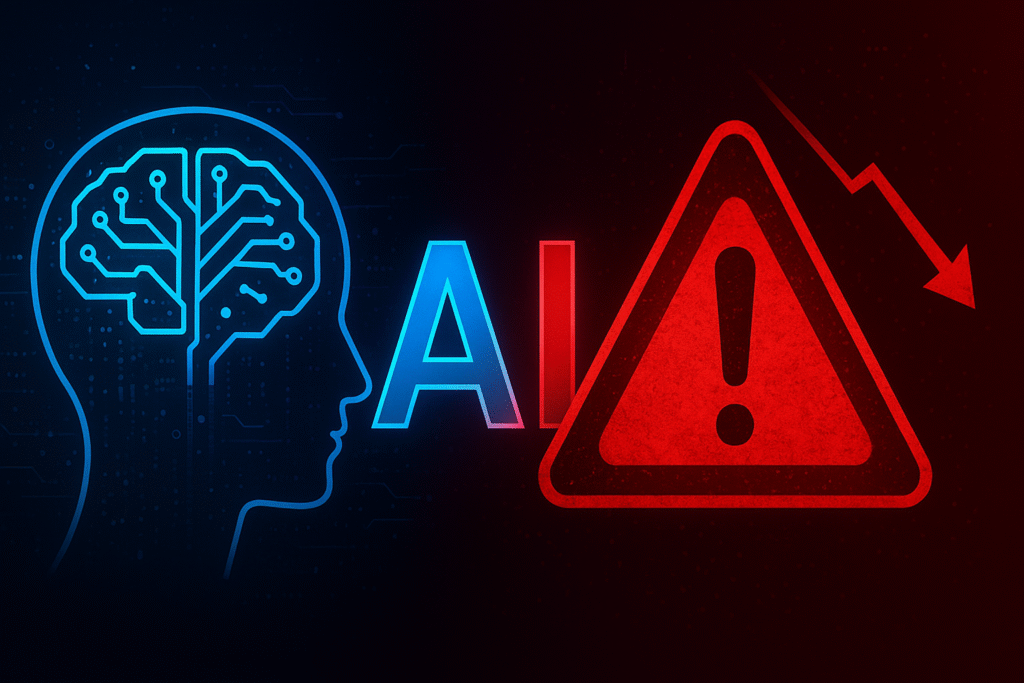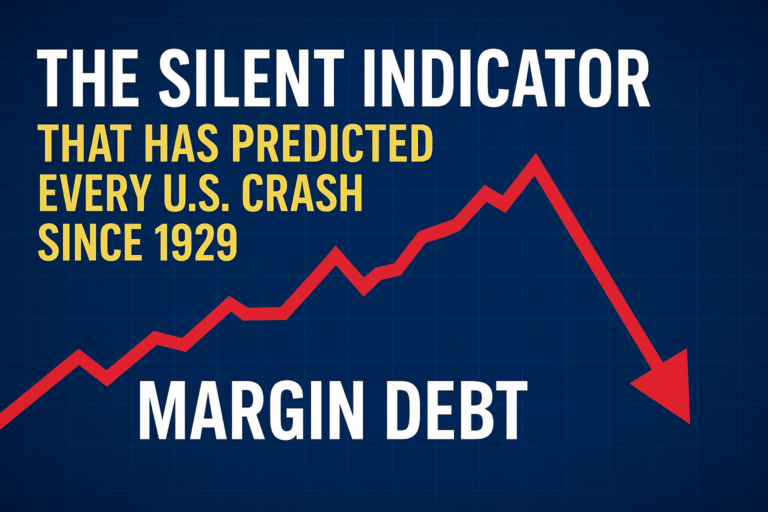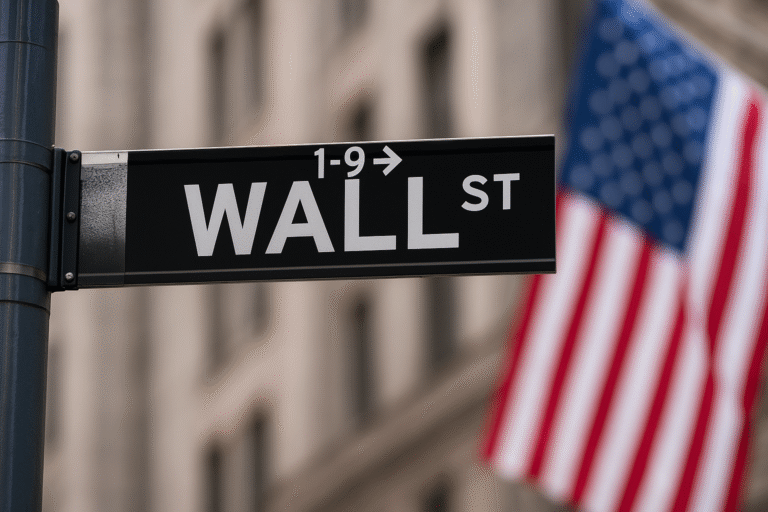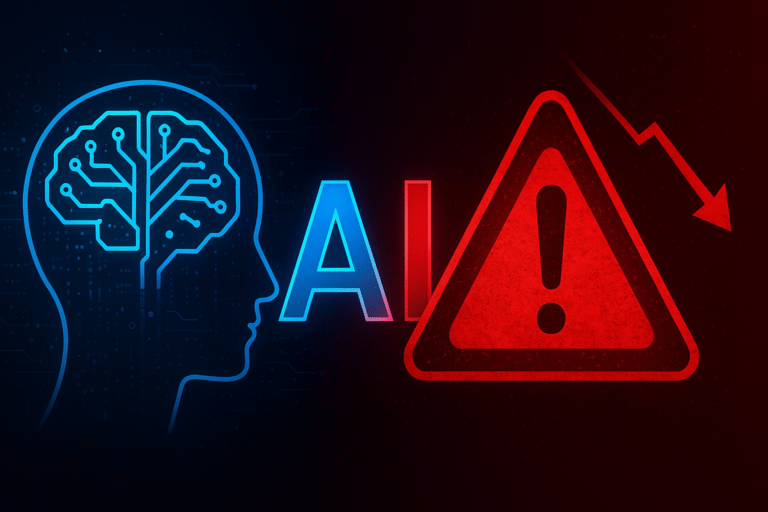
Artificial intelligence (AI) has become the hottest story in finance. From Nvidia’s meteoric rise to startups branding themselves “AI-first” overnight, investors are pouring billions into the sector. In 2023 alone, global private AI investment reached $68 billion (PitchBook) — more than double the annual average of the last decade.
The excitement is justified: AI is revolutionizing industries from healthcare to finance. But here’s the uncomfortable truth — every great technological breakthrough in history, from railroads to dot-coms to crypto, has also fueled a bubble. And when bubbles burst, even the best companies get dragged down temporarily.
So how can you tell whether AI is on the road to becoming the next bubble? The answer lies in tracking the indicators beneath the hype. Let’s break down the six most important red flags investors should monitor right now.
1. Valuation Extremes: The Price-to-Dreams Ratio
Valuation is the clearest warning sign. Nvidia, the poster child of the AI boom, hit a market cap of $3 trillion in mid-2024, briefly overtaking Apple. Its price-to-earnings ratio soared above 70, nearly double its 10-year average of ~40.
This isn’t limited to Nvidia. Many AI-linked companies are trading at price-to-sales multiples north of 20, a level not seen since the dot-com bubble. When investors are willing to pay almost any price for growth that hasn’t materialized yet, it’s a sign exuberance may be replacing logic.
2. The Hype vs. Reality Gap
History shows bubbles form when narrative outruns substance. During the dot-com boom, companies added “.com” to their names and watched share prices skyrocket. Today, we’re seeing the same with “AI.”
- Dozens of small-cap firms rebranded themselves as “AI plays” in 2023–24 despite having little to no AI revenue.
- ETFs with “AI” in their name have multiplied, pulling in billions in inflows.
- Analysts at Bloomberg note that companies mentioning “AI” in earnings calls skyrocketed by over 300% in 2023.
Not all of these firms are true innovators. Many are riding the wave of investor psychology — which always ends the same way.
3. IPO & Venture Capital Frenzy
One of the most reliable signs of a bubble is a flood of new money into unproven companies.
- According to Crunchbase, AI-related startups raised $68 billion in 2023 — nearly 20% of all global VC funding.
- Dozens of AI firms are lining up to go public, many with little to no profitability.
- The AI IPO pipeline resembles the late 1990s dot-com boom, where cash-burning firms rushed to market before the window closed.
When unprofitable companies raise billions purely on the promise of AI, the bubble warning lights start flashing.
4. Retail Frenzy: FOMO in Action
Retail investors often pile in near the top of bubbles. The meme stock era of 2021 showed us what happens when speculation overtakes fundamentals, and AI could be seeing a repeat.
- Retail flows into AI-linked ETFs like Global X Robotics & Artificial Intelligence ETF (BOTZ) surged to record highs in 2024.
- Options trading in Nvidia hit unprecedented levels, with retail traders betting heavily on short-term “lottery ticket” gains through zero-day-to-expiration (0DTE) contracts.
- Household equity exposure in the U.S. climbed back near record highs at 45% of total financial assets — a level last seen just before the 2000 dot-com crash.
When retail investors treat AI stocks as a one-way ticket to wealth, it’s often a sign of overexcitement.
5. Debt-Fueled Buybacks and Speculation
Here’s a quieter but powerful indicator: corporate debt being used to fund buybacks while marketing companies as “AI-driven.”
- In 2023, S&P 500 companies spent nearly $925 billion on stock buybacks — much of it financed by cheap debt.
- Several firms now highlight AI initiatives in press releases while borrowing money to boost earnings per share (EPS).
This mirrors behavior seen before the 2008 crash, where financial engineering disguised weakness until credit conditions tightened.
6. Macro Disconnect: Sky-High AI Stocks vs. Slowing Growth
The final and perhaps most important indicator is the disconnect between AI valuations and broader economic reality.
- While AI stocks soar, U.S. GDP growth slowed to 2.1% annualized in mid-2024, and global growth remains under pressure from inflation and debt.
- Productivity gains from AI haven’t yet shown up in macroeconomic data — they remain projections rather than results.
- Historically, when a sector’s valuations diverge too far from the underlying economy, corrections follow (think dot-coms in 2000 or housing in 2007).
The Bottom Line: Not All AI Is a Bubble — But Risk Is Rising
AI is a transformative technology, just like the internet was in the 1990s. But even the internet revolution went through a brutal correction before the winners emerged. Amazon lost 90% of its value in the dot-com bust before becoming the giant it is today.
The lesson? Innovation can be real — and still wrapped in a bubble.
The key indicators — extreme valuations, hype over substance, IPO frenzy, retail FOMO, debt-fueled speculation, and macro disconnects — suggest that while AI’s long-term future is bright, the short-term path could be rocky.
Every bubble begins with genuine innovation — railroads, electricity, the internet, crypto. AI is no different. But the line between sustainable growth and speculative mania is thin.
The six indicators above are the whispers beneath the noise. Ignore them, and history may repeat. Listen to them, and you might just sidestep the next financial storm.




